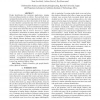20 search results - page 3 / 4 » Adaptation to Walking Direction Changes for Gait Identificat... |
CVPR
2006
IEEE
14 years 8 months ago
2006
IEEE
Human identification from gait is a challenging task in realistic surveillance scenarios in which people walking along arbitrary directions are shot by a single camera. In this pa...
ICRA
2003
IEEE
13 years 11 months ago
2003
IEEE
Abstract—This paper presents a systematic approach to generate walking primitive databases for anthropomorphic 3D–bipeds allowing step length adaptation, direction changes and ...
ICIP
2010
IEEE
13 years 4 months ago
2010
IEEE
People identification has numerous applications, ranging from surveillance/security to robotics. Face and body movement/gait biometrics are the most important tools for this task....
APGV
2009
ACM
13 years 10 months ago
2009
ACM
We conducted two experiments to investigate effects of scale changes on distance perception in virtual environments. In both experiments, participants first made distance estimat...
IJRR
2006
13 years 6 months ago
2006
The first functional load-carrying and energetically autonomous exoskeleton was demonstrated at U.C. Berkeley, walking at the average speed of 0.9 m/s (2 mph) while carrying a 34 ...


